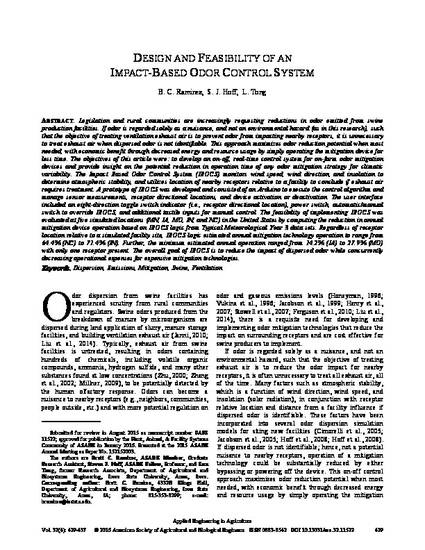
Legislation and rural communities are increasingly requesting reductions in odor emitted from swine production facilities. If odor is regarded solely as a nuisance, and not an environmental hazard (as in this research), such that the objective of treating ventilation exhaust air is to prevent odor from impacting nearby receptors, it is unnecessary to treat exhaust air when dispersed odor is not identifiable. This approach maximizes odor reduction potential when most needed, with economic benefit through decreased energy and resource usage by simply operating the mitigation device for less time. The objectives of this article were: to develop an on-off, real-time control system for on-farm odor mitigation devices and provide insight on the potential reduction in operation time of any odor mitigation strategy for climatic variability. The Impact Based Odor Control System (IBOCS) monitors wind speed, wind direction, and insolation to determine atmospheric stability, and utilizes location of nearby receptors relative to a facility to conclude if exhaust air requires treatment. A prototype of IBOCS was developed and consisted of an Arduino to execute the control algorithm and manage sensor measurements, receptor directional locations, and device activation or deactivation. The user interface included an eight-direction toggle switch indicator (i.e., receptor directional location), power switch, automatic/manual switch to override IBOCS, and additional tactile inputs for manual control. The feasibility of implementing IBOCS was evaluated at five simulated locations (MN, IA, MO, IN, and NC) in the United States by computing the reduction in annual mitigation device operation based on IBOCS logic from Typical Meteorological Year 3 data sets. Regardless of receptor location relative to a simulated facility site, IBOCS logic estimated annual mitigation technology operation to range from 64.4% (NC) to 71.4% (IN). Further, the minimum estimated annual operation ranged from 14.2% (IA) to 27.9% (MO) with only one receptor present. The overall goal of IBOCS is to reduce the impact of dispersed odor while concurrently decreasing operational expenses for expensive mitigation technologies.
Available at: http://works.bepress.com/steven_hoff/140/

This article is from Applied Engineering in Agriculture 32 (2016): 429–437, doi:10.13031/aea.32.11522. Posted with permission.